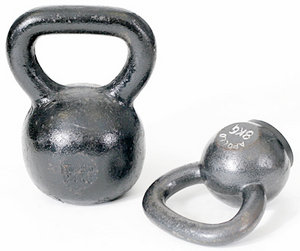To Your Health
April, 2009 (Vol. 03, Issue 04) |
|
|
In January 2008, I started using kettlebells in my exercise classes. I only have women in my classes and these women are noticing better changes in body composition than anything else we were doing in the past. Kettlebells are helping these women tone and tighten their shoulders, back muscles, arms, forearms, midsection and legs.
Here is a short list of workout equipment the kettlebell can replace: barbells, dumbbells, belts for weighted pull-ups and dips, thick bars, lever bars, medicine balls, grip devices, and cardio equipment. Two or three different-size kettlebells are all you need. Non-injured patients and clients familiar with weight training initially start with a 26 lb or 35 lb kettlebell. Rehab patients usually start with a lighter weight. And kettlebells do not take up much space, so you can train in a small area.
I have always advocated free weights more than machines, because free weights are more functional and duplicate real life. Where else are we sitting down and pushing weights except in a gym? Using kettlebells for exercise is even more fun and functional than dumbbells. I actually think they are much harder to handle than dumbbells - which is a good thing in the long run, because they will challenge your body. Kettlebell handles are generally thicker than dumbbells and will give you a vice grip in no time. Also, the off-centered weight of a kettlebell will force you to use more core muscles. Kettlebell training will activate stabilizer muscles, challenge balance and get you to transfer energy from one body segment to another.
 One of the most fundamental and popular kettlebell exercises is called the "swings." Repeating the swings over and over helps you learn to generate force from your body's powerhouse: the hips, legs, back and core. Once you have mastered the kettlebell swing, not only will you instantly get the feel and sense of more complex kettlebell lifts, but your body also will innately apply these lessons to your chosen sport, martial art or weight training. Swings make the deadlift functional, get you connected to the ground and transfer energy through the shoulders. Swings involve a snapping action of the hips, and I have found that this movement targets the gluteals better than bridges and are as good as squats.
One of the most fundamental and popular kettlebell exercises is called the "swings." Repeating the swings over and over helps you learn to generate force from your body's powerhouse: the hips, legs, back and core. Once you have mastered the kettlebell swing, not only will you instantly get the feel and sense of more complex kettlebell lifts, but your body also will innately apply these lessons to your chosen sport, martial art or weight training. Swings make the deadlift functional, get you connected to the ground and transfer energy through the shoulders. Swings involve a snapping action of the hips, and I have found that this movement targets the gluteals better than bridges and are as good as squats.
For sports, you need explosive hips, stable joints, and quick hands. Kettlebell training develops those attributes. Most of the moves are done standing, (bilateral leg stance or single leg stance) and many moves are done lying supine. Multi-joint movements comprise most of the drills. Kettlebells complement core stabilization, body-weight exercises and band exercises. Many exercise maneuvers are characteristic of work, sports and activities of daily living.
Break Up the Routine
One of the biggest mistakes you can make is performing the same fitness routine month after month, year after year. I've heard stories of people who've been doing the same workout for literally years. They do the same exercises, same weights, same workout order, and enjoy the same lack of results. Don't allow yourself to become "process oriented" and just go through the motions at each workout. You have to change your workout program every 8-12 weeks because the body will neutralize the beneficial effects of any exercise protocol to which it is continually subjected. Your body will plateau and you'll stop seeing improvements.

